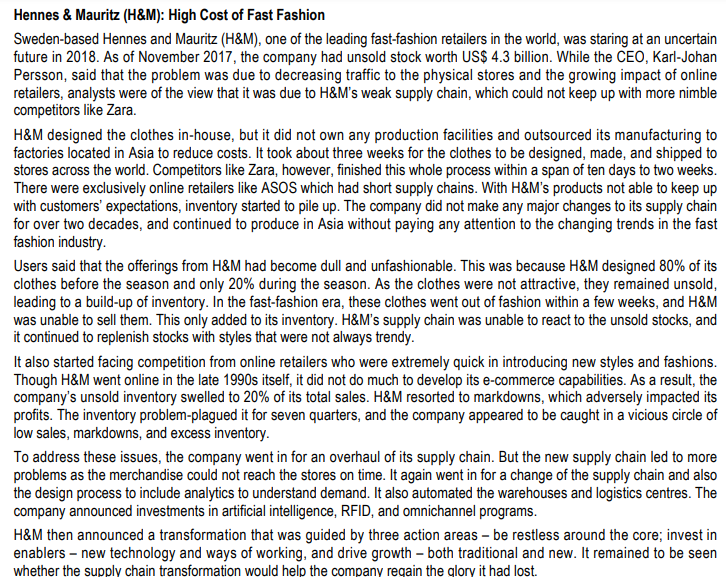With proving examples from the case information provided - Discuss any 4 important supply chain processes?
With proving examples from the case information provided - Discuss any 4 important supply chain processes?
Chapter1: Taking Risks And Making Profits Within The Dynamic Business Environment
Section: Chapter Questions
Problem 1CE
Related questions
Question
With proving examples from the case information provided - Discuss any 4 important supply chain processes?

Transcribed Image Text:Hennes & Mauritz (H&M): High Cost of Fast Fashion
Sweden-based Hennes and Mauritz (H&M), one of the leading fast-fashion retailers in the world, was staring at an uncertain
future in 2018. As of November 2017, the company had unsold stock worth US$ 4.3 billion. While the CEO, Karl-Johan
Persson, said that the problem was due to decreasing traffic to the physical stores and the growing impact of online
retailers, analysts were of the view that it was due to H&M's weak supply chain, which could not keep up with more nimble
competitors like Zara.
H&M designed the clothes in-house, but it did not own any production facilities and outsourced its manufacturing to
factories located in Asia to reduce costs. It took about three weeks for the clothes to be designed, made, and shipped to
stores across the world. Competitors like Zara, however, finished this whole process within a span of ten days to two weeks.
There were exclusively online retailers like ASOS which had short supply chains. With H&M's products not able to keep up
with customers' expectations, inventory started to pile up. The company did not make any major changes to its supply chain
for over two decades, and continued to produce in Asia without paying any attention to the changing trends in the fast
fashion industry.
Users said that the offerings from H&M had become dull and unfashionable. This was because H&M designed 80% of its
clothes before the season and only 20% during the season. As the clothes were not attractive, they remained unsold,
leading to a build-up of inventory. In the fast-fashion era, these clothes went out of fashion within a few weeks, and H&M
was unable to sell them. This only added to its inventory. H&M's supply chain was unable to react to the unsold stocks, and
it continued to replenish stocks with styles that were not always trendy.
It also started facing competition from online retailers who were extremely quick in introducing new styles and fashions.
Though H&M went online in the late 1990s itself, it did not do much to develop its e-commerce capabilities. As a result, the
company's unsold inventory swelled to 20% of its total sales. H&M resorted to markdowns, which adversely impacted its
profits. The inventory problem-plagued it for seven quarters, and the company appeared to be caught in a vicious circle of
low sales, markdowns, and excess inventory.
To address these issues, the company went in for an overhaul of its supply chain. But the new supply chain led to more
problems as the merchandise could not reach the stores on time. It again went in for a change of the supply chain and also
the design process to include analytics to understand demand. It also automated the warehouses and logistics centres. The
company announced investments in artificial intelligence, RFID, and omnichannel programs.
H&M then announced a transformation that was guided by three action areas - be restless around the core; invest in
enablers - new technology and ways of working, and drive growth - both traditional and new. It remained to be seen
whether the supply chain transformation would help the company regain the glory it had lost.
Expert Solution
This question has been solved!
Explore an expertly crafted, step-by-step solution for a thorough understanding of key concepts.
Step by step
Solved in 2 steps

Recommended textbooks for you

Understanding Business
Management
ISBN:
9781259929434
Author:
William Nickels
Publisher:
McGraw-Hill Education

Management (14th Edition)
Management
ISBN:
9780134527604
Author:
Stephen P. Robbins, Mary A. Coulter
Publisher:
PEARSON

Spreadsheet Modeling & Decision Analysis: A Pract…
Management
ISBN:
9781305947412
Author:
Cliff Ragsdale
Publisher:
Cengage Learning

Understanding Business
Management
ISBN:
9781259929434
Author:
William Nickels
Publisher:
McGraw-Hill Education

Management (14th Edition)
Management
ISBN:
9780134527604
Author:
Stephen P. Robbins, Mary A. Coulter
Publisher:
PEARSON

Spreadsheet Modeling & Decision Analysis: A Pract…
Management
ISBN:
9781305947412
Author:
Cliff Ragsdale
Publisher:
Cengage Learning

Management Information Systems: Managing The Digi…
Management
ISBN:
9780135191798
Author:
Kenneth C. Laudon, Jane P. Laudon
Publisher:
PEARSON

Business Essentials (12th Edition) (What's New in…
Management
ISBN:
9780134728391
Author:
Ronald J. Ebert, Ricky W. Griffin
Publisher:
PEARSON

Fundamentals of Management (10th Edition)
Management
ISBN:
9780134237473
Author:
Stephen P. Robbins, Mary A. Coulter, David A. De Cenzo
Publisher:
PEARSON